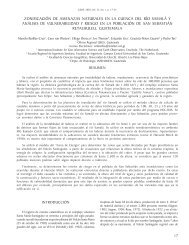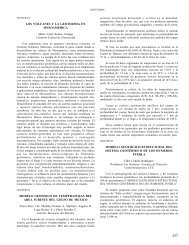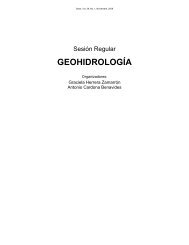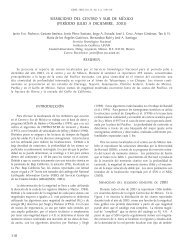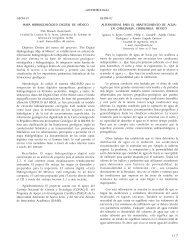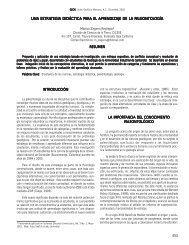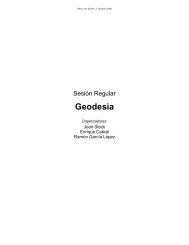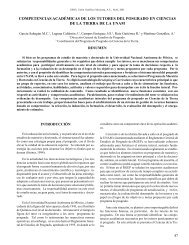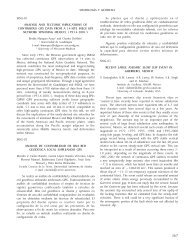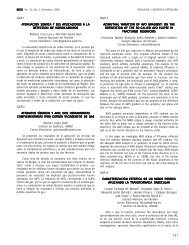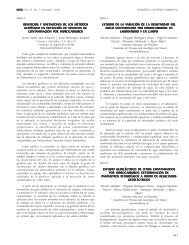Libro de resúmenes - Unión Geofisica Mexicana AC
Libro de resúmenes - Unión Geofisica Mexicana AC
Libro de resúmenes - Unión Geofisica Mexicana AC
Create successful ePaper yourself
Turn your PDF publications into a flip-book with our unique Google optimized e-Paper software.
Geos, Vol. 31, No. 1, Noviembre, 2011MODEL<strong>AC</strong>IÓN MATEMÁTICA Y COMPUT<strong>AC</strong>IONAL DE SISTEMASTERRESTRESresultados para un caso <strong>de</strong> estudio sencillo y un análisis <strong>de</strong> aceleración <strong>de</strong>ltiempo <strong>de</strong> cálculo.SE01-6UN MODELO DE FLUJO SUBTERRÁNEO DE LARECARGA DEL <strong>AC</strong>UÍFERO DEL VALLE DE LEÓN, GTO.Luna Andra<strong>de</strong> Mónica Azucena y Hernán<strong>de</strong>z García Guillermo <strong>de</strong> JesúsInstituto <strong>de</strong> Geofísica, UNAMmonicaa.luna@gmail.comEn este trabajo se analiza numéricamente la recarga <strong>de</strong>l acuífero <strong>de</strong>l Valle<strong>de</strong> León, Gto. Dicho análisis se realizó mediante las ecuaciones en <strong>de</strong>rivadasparciales en 3D que representan el flujo <strong>de</strong> agua subterránea en un medioporoso, y que son aproximadas numéricamente usando el programa VISUALMODFLOW.Se presenta la teoría básica y generalida<strong>de</strong>s científicas <strong>de</strong> los acuíferos, losfundamentos teóricos y experimentales que permiten hacer el análisis <strong>de</strong>lreservorio y se explica la manera en que se llega a la aproximación endiferencias finitas <strong>de</strong>l mo<strong>de</strong>lo hidrodinámico <strong>de</strong> flujo. Se presentan datos ylos estudios previos <strong>de</strong>l acuífero para <strong>de</strong>scribir minuciosamente cómo estáconstituido. Posteriormente, se explica el mo<strong>de</strong>lo previo <strong>de</strong>l cual se obtuvieronlas recargas para tres intervalos <strong>de</strong> tiempo <strong>de</strong> 10, 25 y 50 años.Este análisis, nos muestra la cantidad <strong>de</strong> agua necesaria para garantizar elabastecimiento suficiente <strong>de</strong> este recurso para las necesida<strong>de</strong>s <strong>de</strong>l Valle <strong>de</strong>León, Gto. en los años veni<strong>de</strong>ros. También nos hace notar que la recargaactual en este sistema-acuífero tomando en cuenta los volúmenes infiltrados através <strong>de</strong> la siembra <strong>de</strong> agua <strong>de</strong> lluvia y las evaluaciones en el mo<strong>de</strong>lo <strong>de</strong> flujoevi<strong>de</strong>ncian la necesidad <strong>de</strong> una gran cantidad <strong>de</strong> tiempo que haga notorio elcambio <strong>de</strong> nivel <strong>de</strong>l agua en el reservorio causado por la recarga natural.SE01-7THE DERIVED-VECTOR SP<strong>AC</strong>E: A UNIFIED FRAMEWORK FORNON-OVERLAPPING DOMAIN DECOMPOSITION METHODSHerrera Revilla IsmaelInstituto <strong>de</strong> Geofísica, UNAMiherrera@geofisica.unam.mxWe introduce a ‘primal’ framework, which we call the ‘<strong>de</strong>rived-vector space(DVS) framework’ that permits a synthetic and effective integration of both:primal and ‘dual’ formulations of non-overlapping domain <strong>de</strong>compositionmethods with constraints, including those most commonly used: BDDC,prototype of primal formulations, and FETI-DP, prototype of dual formulations.The most prestigious primal framework that exists today was introduced byDohrmann and BDDC was <strong>de</strong>veloped in that setting. Therefore, it is similar tothe <strong>de</strong>rived-vector space (DVSD) framework, albeit a significant difference isthat, in the DVS framework, the problem consi<strong>de</strong>red is transformed into onethat is <strong>de</strong>fined in a product vector space and, thereafter, all the numerical workis carried out in the <strong>de</strong>rived-vector space. Nothing like that is done in BDDC.Another important difference is that the DVS has a Hilbert-space structurethat is <strong>de</strong>fined even when the problems are non-symmetric or in<strong>de</strong>finite. Thismanner of approaching DDM simplifies the algorithmic formulations, whichare summarized in a set of eight matrix-formulas applicable to the matricesthat are generated when treating numerically partial differential equations orsystems of such equations; furthermore, such matrices may be symmetric,non-symmetric and in<strong>de</strong>finite. They can be, and have been, directly used forco<strong>de</strong> <strong>de</strong>velopment; all the information that is required to know in or<strong>de</strong>r to applythem is the system-matrix of the original continuous problem. Of the set offormulas mentioned above, two preconditioned matrix-formulas had not beenreported previously in the literature, albeit they have a state-of-the-art efficiency.Keywords: Iterative substructuring, non-overlapping domain <strong>de</strong>composition;BDD, BDDC; FETI, FETI-DP; preconditioners; product space; LagrangemultipliersSE01-8MÉTODOS DE DESCOMPOSICIÓN DE DOMINIOAJENOS PARA PROBLEMAS NO SIMÉTRICOSRosas Medina Agustín Alberto y Herrera Revilla IsmaelInstituto <strong>de</strong> Geofísica, UNAMalbertico@geofisica.unam.mxSe presenta una visión general <strong>de</strong> los métodos <strong>de</strong> <strong>de</strong>scomposición <strong>de</strong> dominiocon dominios ajenos. En este trabajo a los métodos más eficientes talescomo balancing domain <strong>de</strong>composition (BDD) y finite element thearing andinterconnecting (FETI) se les ubica <strong>de</strong>ntro <strong>de</strong> un marco teórico <strong>de</strong>sarrollado porHerrera y colaboradores, conocido como “<strong>de</strong>rived-vector space”. Dentro <strong>de</strong> estemarco se incluyen los métodos más usados comúnmente: BDDC, prototipo <strong>de</strong>las formulaciones primal y FETI-DP, prototipo <strong>de</strong> las formulaciones dual. Cabemencionar que FETI y sus variantes trabajan con recursos <strong>de</strong> multiplicadores <strong>de</strong>Lagrange y en el caso <strong>de</strong> BDD y sus variantes aborda los problemas sin recurso<strong>de</strong> multiplicadores <strong>de</strong> Lagrange. Estas fórmulas matriciales son igualmenteaplicables a matrices simétricas y no simétricas provenientes <strong>de</strong> una ecuacióndiferencial o <strong>de</strong> un sistema <strong>de</strong> tales ecuaciones, y para el <strong>de</strong>sarrollo <strong>de</strong> loscódigos computacionales basta conocer las matrices provenientes <strong>de</strong>l problemaoriginal. Los resultados numéricos que se muestran son aplicados a problemasno simétricos y a<strong>de</strong>más con problemas <strong>de</strong> advección dominante.Keywords: Métodos <strong>de</strong> <strong>de</strong>scomposición <strong>de</strong> dominio, BDD, BDDC, FETI,FETI-DP, advección-difusión.SE01-9DDM APPLIED TO SUBSURF<strong>AC</strong>E FLOW AND TRANSPORTHernán<strong>de</strong>z García Guillermo <strong>de</strong> JesúsInstituto <strong>de</strong> Geofísica, UNAMgh<strong>de</strong>z@geofisica.unam.mxParallel computing is one of the most effective methods for increasingcomputational speed. On the base of this method, in this work variousmathematical and numerical techniques were <strong>de</strong>veloped to apply domain<strong>de</strong>composition methods. Applying this method and the finite element methods,to the flow and transport in porous media, it was possible to obtain efficientparallelization of the governing equations in reservoirs with dominant advection.The domain <strong>de</strong>composition method has been investigated recently by severalauthors for bi-dimensional and tri-dimensional elliptic and parabolic problems.This method is attractive because it permits parallel processing of finer meshesto approach the domain at transport problems.We consi<strong>de</strong>r some simple iterative sub-structuring methods that rely on apartition non-overlapping sub-domain. At the global domain an internal boundarya local domains are <strong>de</strong>fined. The Schur complement matrix, relative to theunknowns on the internal boundary is obtained. This matrix can be found bysub-assembling local contributions. In particular solving the Schur system for theunknowns at the internal boundary, the internal components can be found.A co<strong>de</strong> was <strong>de</strong>veloped for the Domain Decomposition Method, DDM, appliedto the Transport in porous media. This approach yields simple unifiedmatrix-expressions, in terms of a generalized Schur-complement matrix.Applying this method, to the flow and transport in porous media, permit to obtainefficient parallelization of the governing equations in reservoirs with dominantadvection.SE01-10FINITE VOLUME SIMULATION OF A TWO PHASE FLOW MODELIN POROUS MEDIA USING MULTICORE ARCHITECTURESDe la Cruz Salas Luis Miguel y Monsivais Velazquez DanielInstituto <strong>de</strong> Geofísica, UNAMluiggi@unam.mxIn this work we present a numerical solution of a two-phase flow mo<strong>de</strong>l inporous media based in the black oil mo<strong>de</strong>l assumptions, commonly used inpetroleum engineering. The mathematical mo<strong>de</strong>l is formulated in terms of a twonon-linear partial differential equations, one for a non-wetting phase pressure(oil) and a the other one for a wetting phase saturation (water). To solve thesenon-linear and coupled equations, we use the well-known improved IMPESalgorithm: the pressure equation is first solved implicitly, and once the pressurevalues are obtained, they are used to explicitly <strong>de</strong>termine the saturation values.Besi<strong>de</strong>s, we take a much larger time step for the pressure than for the saturation.The equations are discretized using a finite volume strategy in combinationwith several approximation schemes to calculate the saturation on the faces ofthe volumes. Comparisons of the accuracy of these schemes are presented.The solution of the linear system for the pressure equation is solved usingthree implementations of the BiCGstab Krylov method. These implementationswere done for shared memory architectures with OpenMP and CUDA, andfor distributed memory architectures with PETSc. Several case studies arepresented and the speedup for the three parallel techniques before mentionedis discussed.SE01-11MODELOS M<strong>AC</strong>ROHIBRIDOS MIXTOS EN DOMINIOS GENERALES EN 3DVera Guzmán NorbertoInstituto <strong>de</strong> Geofísica, UNAMnrbrtvr@gmail.comEn este trabajo se plantea un mo<strong>de</strong>lo macrohíbrido mixto <strong>de</strong> flujo en mediosporosos en una geometría general en 3D, con el propósito <strong>de</strong> aplicar cóomputo137



![Libro de resúmenes [revisión final, 172 páginas] - UGM](https://img.yumpu.com/51565067/1/190x245/libro-de-resamenes-revisian-final-172-paginas-ugm.jpg?quality=85)
